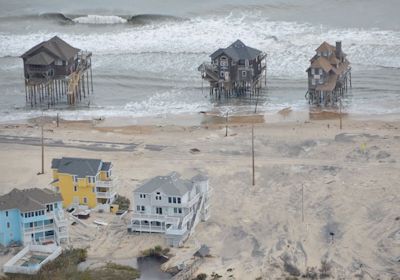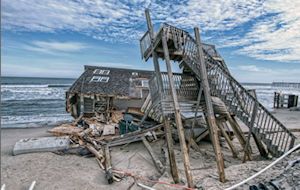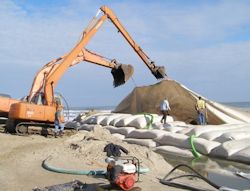Reprinted from the Island Free Press
 Hurricane Sandy stripped away the the beach, leaving houses at the border of Rodanthe and the Pea Island National Wildlife Refuge facing the ocean. Photo: Program for the Study of Developed Shorelines, Western Carolina University |
RODANTHE — Piles of debris lining N.C. 12 through Rodanthe will be carted off by Dare County, but county officials say that the remains of houses scattered up and down the beach must be removed by the property owners.
A house at the end of Dean Avenue fell into the ocean on Dec. 30 and was still sitting in the water days later, its interior exposed and the gaping contents pounded by surf. Some of the debris has now been washed as far south as Salvo.
Supporter Spotlight
The house, which had been damaged by Hurricane Sandy in October, will be removed by a contractor hired by the property owner Debbie Burns, said county manager Bobby Outten.
Outten said other people with damaged houses also are expected to remove any associated debris from the oceanfront.
“We are not allowed to clean up private property with tax dollars,” Outten said. “The property owners bring the debris to the curb. What we do on our end is push them to get that done quickly.”
Since there was not a presidential declaration related to Hurricane Sandy in Dare County, no federal emergency funds are available for clean-up costs, he said. As a consequence, most of the debris removal is being done by county workers who have been diverted from their regular tasks.
“It’s going to take weeks,” Outten said. “We’re going as fast as we can.”
Supporter Spotlight
But with hot tubs, toilets, sinks, remnants of cabinets and the remains of stairs, walls and floors scattered over miles in the surf, the foreshore and the dry beach, the question of who is responsible for what debris is unclear.
Outten said that the National Park Service beach north of the Rodanthe pier has eroded away, but the dry sand is private property and the wet sand is still either federal or state property.
 Debris piles litter the beach at Rodanthe. Photo: Don Bowers, Island Free Press |
The Park Service’s Solicitor General’s office issued an opinion a year or so ago that the foreshore area between the mean high water line and the mean low water line remains Park Service property, said Steve Thompson, NPS special park uses and lands coordinator.
“That area belongs to the Park Service no matter where it is located,” he said. “It’s our jurisdiction and it’s ocean beach for the public and it’s administered by the Park Service.”
But Thompson said that the park is not planning to clean the debris off the beach.
“The Park Service’s position is that it is the responsibility of the homeowner,” he said, “to the extent that we can identify it.”
With the beach along Mirlo Beach mostly eroded away, oceanfront homes and the highway are especially vulnerable to powerful storm-driven waves. In recent years, two houses on the north end of the subdivision have been lost, and another one is teetering in the surf.
The northern-most house had been issued a permit to move before Sandy hit, said Donna Creef, the county planning director. But the owners did not have time to relocate the house before the storm.
As of last week, she said, there were 29 houses on the beachfront in Rodanthe that were still under “unsafe structure” notice by the county. Of them, 15 were in Mirlo Beach, on the north end of the village.
Workers with the state Department of Transportation are in the process of rebuilding gigantic sand dunes by the S-curves, an area on the south end of Pea Island National Wildlife Refuge, just north of Mirlo. The road recently reopened there after being replaced.
Ocean overwash and sand on N.C. 12 has been a constant headache for DOT at the S-curves and Mirlo, with the road repeatedly damaged or destroyed by storms. After Hurricane Irene in August 2011, for instance, tide from the sound tore up the roadbed on N.C. 12 and portions of Mirlo’s private roads and driveways.
 The N.C. Department of Transportation is building a wall of huge sand bags to try and protect storm-ravaged N.C. 12. Photo: DOT |
The county and DOT are separately investigating the possibility of doing beach nourishment to widen the beach in the area.
Thompson said any nourishment project would be required to meet agency regulations, and the Park Service in the past has frowned on such projects.
“It’s not a matter of whether the Park Service is going to allow it or not,” he said. “It’s a permitting issue.”
Mirlo Beach homeowners have been pushing for beach nourishment as the best solution. In the meantime, they have been rebuilding the dunes in front of their houses that were flattened during Sandy, said Wes Hutchinson, vice-president of the Mirlo Beach Home Owners’ Association.
There has also been a side benefit of the dune construction.
“Right now there’s a lot of nourishment by default from the sand dunes they’re building,” he said.
Most of the damaged houses south of Blue Sea Road in Mirlo will be restored, he said. Property owners recently cleaned up storm debris that had collected in the subdivision’s wetland area on the west side of the highway.
Despite the continual challenges with erosion and transportation access at Mirlo, Hutchinson said that oceanfront houses are still being sold, at least some in foreclosure sales.
“They do rent fairly well,” he said, “as long as they keep standing.”
But the house that fell in the ocean last weekend was on the other end of Rodanthe near the pier. And it was a year-round residence the owners had purchased to live out their retirement years.
Creef said she has urged Burns, the owner, to “move as quickly as she can” to get her collapsed house off the beach, but she acknowledged that the county is limited in what it can do.
“A lot of people think ‘Oh, the county needs to get the beach cleaned up,’” she said. “But it’s easier said than done because a lot of that debris is in the water.”







